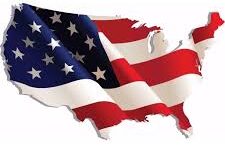The War of 1812 is often called “America’s Forgotten War”, yet it produced an enduring symbol that’s familiar to all Americans, “The Star-Spangled Banner”. Watching the bombardment of Fort McHenry, Francis Scott Key was inspired to describe the moment. Originally penned as a poem titled “Defence of Fort McHenry”, Key’s work would later be renamed “The Star-Spangled Banner”, and became America’s official national anthem in 1931. Given how little Americans know about the War of 1812, I suppose it’s a bit ironic that the conflict gave birth to our national anthem. The lack of knowledge surrounding the War of 1812 is really unfortunate, not only because of its historical significance, but because it’s a fascinating subject.
America invaded Canada, the British burned down the White House, The Battle of Lake Erie resulted in the first unqualified defeat of a British naval squadron in history, and Andrew Jackson would become famous for the Battle of New Orleans, which happened after the Treaty of Ghent had already been signed. While the war ended in a draw, it instilled confidence in a young United States, and in many ways served as a formative moment for the country. It also established America’s credibility with foreign powers. All of that in a war most people know nothing about.
“The war has raised our reputation in Europe…and it excites astonishment that we should have been able for one campaign to have fought Great Britain single handed…I think it will be a long time before we are disturbed again by any of the powers of Europe.”
James Bayard, 1814

I’ve made such references before, but in a hypothetical world where I’m the United States’ Education CzarTM, every child in America would take a field trip to Fort McHenry. A quick Google search tells me that roughly 40% of Americans know all the words to the Star-Spangled Banner. I’m going to venture a guess that the percentage that actually know what the words mean is sub 10%. Hence my fictional plan to send 6th graders on a field trip to Baltimore. It probably wouldn’t hurt for their parents to tag along as well.
Completed in 1805, Fort McHenry was the result of an ambitious fort building program undertaken after the American Revolution. Guarding the entrance to Baltimore Harbor, Fort McHenry was vital to the protection of Baltimore, then America’s third largest city, and one of the country’s most important ports. In September 1814, after destroying Washington D.C., the British set their sights on Baltimore. Early in the morning of September 13, 1814, the British fleet sailed into the Patapsco River, and commenced the bombardment of Fort McHenry. For the next 25 hours, the British artillery pounded Fort McHenry. At 8:30 the following morning, the last shots were fired by the British fleet. It became increasingly clear that the fort couldn’t be taken, and the British fleet retreated down the Patapsco River, heading towards the Chesapeake Bay.
Seeing the British retreat, Fort McHenry’s commander, Major George Armistead, ordered his troops to raise the grand 30×42 foot garrison flag. Commissioned by Major Armistead the year before, the garrison flag was made by Baltimore local Mary Pickersgill, and featured 15 stars and 15 stripes, representing the original 13 colonies plus the two newest states, Kentucky and Vermont. As they raised the flag, the troops fired their guns and played “Yankee Doodle” in celebration of their victory. Watching from a ship in the Patapsco River, Francis Scott Key witnessed the enormous flag being raised, and was inspired to write the “Star-Spangled Banner”. One of America’s great patriotic symbols, the flag from Fort McHenry has been on display at the Smithsonian Museum of American History since 1964.

Now preserved as Fort McHenry National Monument, a visit to this National Park Site is well worth the trip, especially considering how easy it is to visit. Located near downtown Baltimore, Fort McHenry is less than 10 minutes from Camden Yards. I’d bet there are millions of people who’ve visited Baltimore and skipped Fort McHenry, not because it wasn’t interesting, but because they didn’t know it was there.
Fort McHenry is open for self guided tours, and there are plenty of exhibits featuring really fascinating information. You can walk along the perimeter of the fort, where you can admire and learn about the various artillery pieces. You can also explore all of the interior buildings, which feature exhibits on everything from how the troops lived to how the fort operated. In addition to Fort McHenry itself, there’s a really wonderful visitor center, which has more general exhibits detailing the War of 1812. If you’re totally unfamiliar with the war, a quick visit to the visitor center is well worth the time, as it’s a really nice introduction to the conflict.


Where do I go to cast my vote for you to be education czar???😊